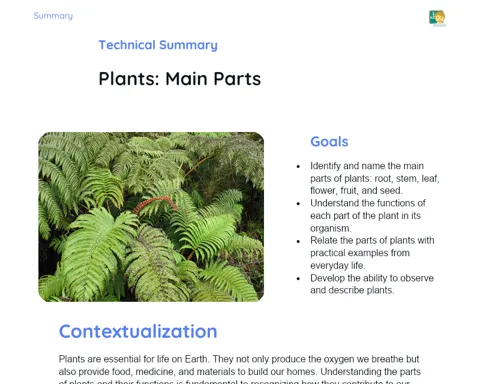Unraveling the Periodic Table: A Practical Guide for Students
Objectives
1. Understand the basic structure of the periodic table.
2. Recognize how elements are organized, including the distinction between metals and nonmetals.
3. Identify the main families, such as the halogens.
Contextualization
The periodic table is an essential tool in chemistry, used to organize all known chemical elements in a way that facilitates their understanding and study. It not only lists the elements but also reveals patterns and trends in their properties. Imagine a treasure map that helps scientists and engineers discover new materials and improve existing technologies, from cell phone batteries to medicines. For example, all alkali metals, such as sodium and potassium, are in the same column because they react similarly.
Relevance of the Theme
In the job market, knowledge of the periodic table is fundamental for various professions, such as chemical engineers who develop new materials, pharmacists who create medicines, and even technology professionals who work with semiconductors in the manufacturing of electronic components. Understanding the periodic table allows predictions about the properties of elements and their chemical reactions, which is crucial for the development of new technologies and materials.
Structure of the Periodic Table
The periodic table is organized into horizontal rows called periods and vertical columns called groups or families. Each element is placed in a specific position based on its atomic number (the number of protons in the nucleus). Elements in the same group share similar chemical properties due to their valence electron configuration.
-
Periods: Horizontal rows that indicate the number of electron shells.
-
Groups/Families: Vertical columns where elements have similar chemical properties.
-
Atomic Number: Defines the position of an element in the periodic table.
Organization of Elements: Metals and Nonmetals
Elements in the periodic table are divided into three main categories: metals, nonmetals, and metalloids. Metals are generally good conductors of heat and electricity, have a metallic luster, and are malleable. Nonmetals are poor conductors of heat and electricity, lack metallic luster, and are brittle in solid state. Metalloids possess intermediate properties between metals and nonmetals.
-
Metals: Good conductors, metallic luster, malleable.
-
Nonmetals: Poor conductors, no metallic luster, brittle.
-
Metalloids: Intermediate properties between metals and nonmetals.
Main Families: Halogens
Halogens are a group of elements found in group 17 of the periodic table. They are highly reactive and form salts when reacting with metals. Halogens include fluorine, chlorine, bromine, iodine, and astatine. Due to their high reactivity, they are used in various industrial and medical applications.
-
Group 17: Location of halogens in the periodic table.
-
Highly Reactive: Tend to form salts with metals.
-
Applications: Used in industries and medicine.
Practical Applications
- Chemical Engineering: Development of new materials based on the properties of elements.
- Medicine: Creation of medicines using specific elements to treat diseases.
- Technology: Production of semiconductors for electronic components, based on the properties of elements.
Key Terms
-
Periodic Table: Organization of chemical elements based on their properties.
-
Metals: Elements that are good conductors of heat and electricity, have a metallic luster, and are malleable.
-
Nonmetals: Elements that are poor conductors of heat and electricity, lack metallic luster, and are brittle.
-
Halogens: Elements of group 17, highly reactive and salt-forming.
Questions
-
How does the organization of the periodic table facilitate the prediction of elements' properties?
-
How are the knowledge of metals and nonmetals applied in everyday life?
-
What is the importance of halogens in industry and medicine?
Conclusion
To Reflect
The periodic table is much more than just a simple list of chemical elements; it is a map that reveals crucial patterns and trends for science and technology. Through it, scientists can predict the behaviors of elements, develop new materials, and create innovative solutions to real-world problems. By better understanding how elements are organized and classified, such as the distinction between metals and nonmetals, and knowing the main families like the halogens, we equip ourselves with fundamental knowledge that has practical applications in various fields, from medicine to engineering. Reflecting on the periodic table allows us to see the underlying beauty and logic of all the matter that surrounds us.
Mini Challenge - Challenge: Assembling the Periodic Table
To consolidate understanding of the periodic table and its organization, we will carry out a practical and fun activity.
- Divide into groups of 4-5 students.
- Each group will receive a set of cards with information about different chemical elements (atomic number, symbol, atomic mass, etc.).
- Using tape, mark the positions of the elements on the floor of the classroom, forming a giant periodic table.
- Organize the elements in their correct locations, considering their properties and families.
- After organizing, each group should present and explain the arrangement of the elements, highlighting the main families and the distinction between metals and nonmetals.



